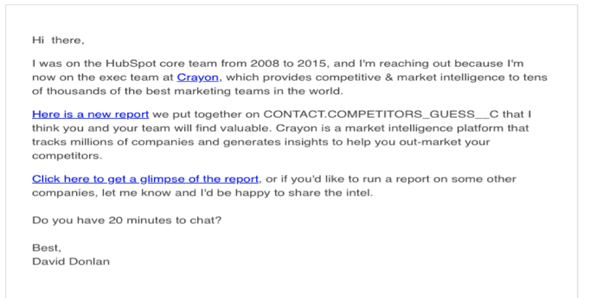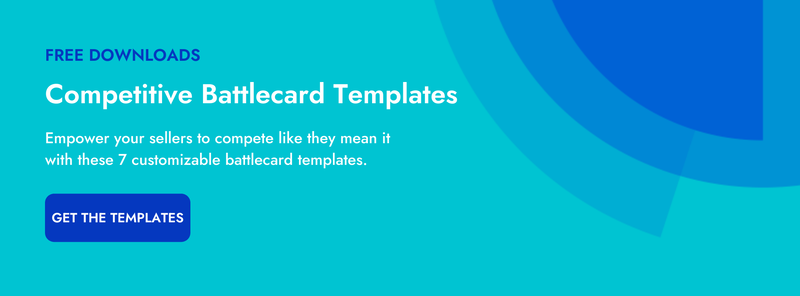There are endless tips and tricks to help sales executives close more deals. One of those tips not talked about enough is using competitive intelligence to win sales. Leveraging competitive intelligence in your sales process can give you that final push in closing the deal. Let’s take a look at the art and science of using competitive intelligence to win sales.
What is Competitive Intelligence?
First, let’s start at the beginning with a key question - what is competitive intelligence? Competitive intelligence is information gathered about your competitors that can, in return, assist you in making better business decisions. Everyone knows what’s happening inside the four walls of their business. But, the real key to success is knowing what your competition is doing so that you can adjust your strategy. Investigating what your competitors are doing allows your team to infer next moves, and plan strategies around the intel. This is beneficial for all teams - marketing, product, and sales, to name a few. The most important factor of competitive intelligence that we’re going to focus on for this article is the ability for your sales team to leverage competitive intel to win more deals. So, how exactly can your sales team use CI in the sales process?
Win more deals with these customizable battlecard templates >>
What Competitive Intel is Beneficial for Your Sales Team
For sales teams, knowing the ins and outs of a competitor can be the tipping point in closing a deal. Competitor profiles and battlecards are helpful as a resource for sales teams to reference details about each of their competitors. Important information to include on battlecards - competitor documents focused on how to win against a competitor - include strengths, weaknesses, objection handling tips, product differences, customer happiness levels, competitive analysis, and more. It’s important that these battlecards are only loaded with validated information, that way your sales team is leveraging truthful information, not opinions or rumors that can land them in hot water with a prospect. This information can be beneficial from start to finish within the sales process, from booking that first meeting to leveraging intel to seal the deal. Now, let’s look at three steps within the sales process that will benefit from your competitive intelligence data.
Grab the Attention of The Decision Maker
The truth of today’s office worker is that on average, they receive 100+ emails per day - that’s a lot of emails. How can you ensure that yours is opened, read, and replied to? If it hasn’t already been established in prior conversations, share the purpose, scope, and tools of what you plan to bring to the business. For example, tell them a little bit about yourself, what your product can do, maybe what it can do better than a competitor, throw in a free sample of what your product is capable of, and open the door to set-up a phone call or demo. Check out this example email below, trying to hook a prospect for Crayon.

Always lead with a differentiator. For Crayon, one of our strengths is that we collect a wide range of incredible data from seven million sources, which is why we lead with the value of our data. This email is sure to grab their attention and they’re likely more interested in engaging in a conversation. Now they’ve seen what the product is capable of accomplishing. It’s critical to track your emails and conversations in your CRM. You want to make sure that you’re following up regularly, and continuing to nurture the relationship.
Educating Your Prospect on the Market
Now, you’ve got your prospect on the phone to discuss your product, maybe you’ve had a few conversations. A key part of making a sale is proving why you’re better than your competition. In one scenario, a prospect says you're in the top 2 choices but they're leaning towards the competitor because they heard that solution has an easier setup and navigation. Sales rep answers not knowing anything about the competitor - hard to argue against. This is where a strong competitive intelligence training and battlecards come in. Even worse, the sales rep could say something that’s not at all true, because the intel came to them in the form of a rumor.
Lead: “Well, I heard that company x’s product is easy to set up and navigate, but that yours takes days to fully set up and your menu is hard to navigate, is this true?”
Biased Sales Rep: “Oh no, that’s just a lie. Our product is five times better, and in fact, our product has the easiest set up. Honestly, their product requires more manual work, and their design is terrible, not ours. Overall, it’s not even as good as our product.”
In return, this sales rep will lose credibility with the prospect, costing them the deal. The sales rep is set on not only attempting to prove the fact wrong, but they also tear down the competitor. That’s a prime example of what not to do.
What sales representatives should be able to do is understand the full scope of their competition, so that when faced with tough questions pinning your company against a competitor, they can answer honestly and build trust between themselves and the prospect.
Build a Trustworthy Relationship with the Potential Customer
Throughout the sales process, it’s important to build trust between yourself and your potential customer. People are more likely to buy from those that they trust. That’s why it’s important that competitive intel is honest and truthful, and that sales representatives are using the data in positive ways. If you continue to provide the potential customer with truthful information, answer all of their questions, and leverage competitive intel in a positive way, you’ll be able to build a trustworthy relationship.
Understanding your competitive landscape is critical when it comes to winning more sales. If you can gain the information, you will gain a competitive edge, and your sales team will be able to close more deals. Three important steps to remember are:
- Don’t only send one email or dial one phone call. Continue to follow-up and nurture the lead.
- Provide the incentive. Show them information that they don’t already know, whether that be through your email communication, or on the phone.
- Do the leg work. Follow up with them, and be sure to answer all of their questions honestly and to the best of your competitive knowledge.
If your sales team keeps these tactics in mind, they will be able to integrate competitive intelligence into their strategy, and win more deals.
Seeing is believing! Check out Crayon for yourself.
Take a Product TourRelated Blog Posts
Popular Posts
-
 The 8 Free Market Research Tools and Resources You Need to Know
The 8 Free Market Research Tools and Resources You Need to Know
-
 6 Competitive Advantage Examples From the Real World
6 Competitive Advantage Examples From the Real World
-
 How to Create a Competitive Matrix (Step-by-Step Guide With Examples + Free Templates)
How to Create a Competitive Matrix (Step-by-Step Guide With Examples + Free Templates)
-
 24 Questions to Consider for Your Next SWOT Analysis
24 Questions to Consider for Your Next SWOT Analysis
-
 How to Measure Product Launch Success: 12 KPIs You Should Be Tracking
How to Measure Product Launch Success: 12 KPIs You Should Be Tracking


